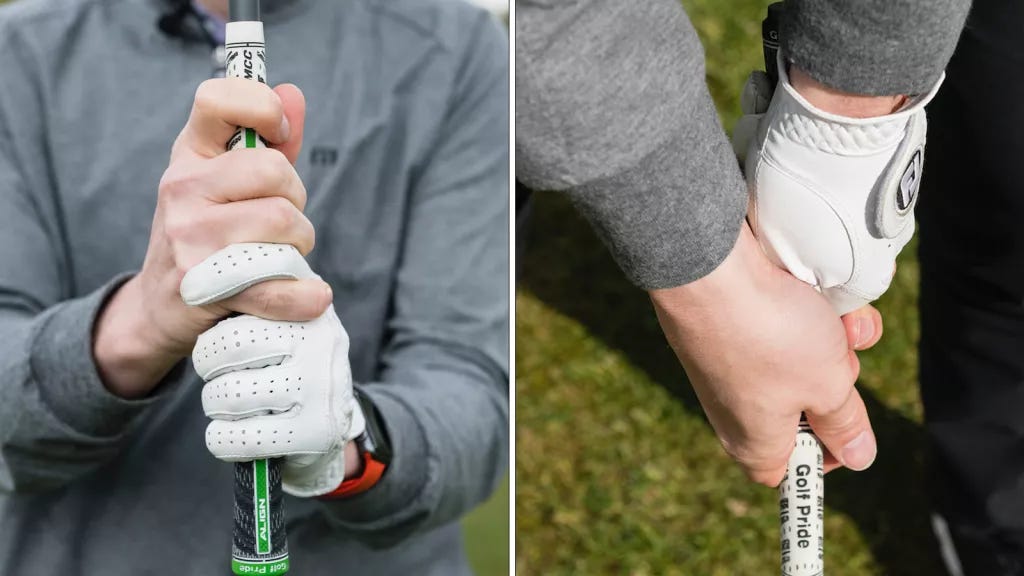Knock, Knock: The new grip is here, and...
After 30 years of a 10-finger grip (baseball, if you will) this winter will be all about interlocking. After one beautiful shot, optimism blends with dread
I realized this past Sunday the road to respectability is long and arduous.
Respectability, I mean, in terms of admiration from peers.
Admiration in knowing you can hang with them.
I was on the 8th fairway of Gresham Golf Course when it hit me; I was 227 yards from the middle of the green, according to my GPS. I don’t own an actual yardage finder, like a Bushnell, but my Garmin watch has the Garmin Golf feature, so…perfect.
Anywho, I was 227 away. This is where the exciting part (for me) comes into play.
Backtracking a bit: I picked up a club roughly three times in my hiatus from the sport (2016-two months ago). But when I did, it felt as it always had. My grip was the same as when I first picked up a club: a traditional ten-finger grip (below). Like riding a bike.
One thing had changed, however, and that came about after a random video popped up on Instagram the first day back hitting in June. The instructor, whose name I forgot, showed that I would have better control by moving the left hand inward and putting my thumb over, essentially tightening the grip on my lead hand. It worked.
Adding in a few new wrinkles to my swing since then, including extending the initial pull back, and keeping my hips in place, has only added to my fresh feel. Throw in the new clubs, and I’m hitting the ball longer, straighter, with more consistent contact than ever before, including when I was playing every day in high school.
But here’s the dilemma: As good as it feels now with the changes, I know that if I want to get my game to the next level (step one: Take my handicap to single digits), I have to adopt the interlocking grip (below).
The benefits of the interlocking grip are almost non-debatable. Used by the best in the sport (Jack, Tiger, McIlroy, Spieth, etc.), interlocking essentially conjoins your hands, ensuring they move as one during the swing. Unless you’re my father-in-law, who has hands the size of Texas, most golfers benefit from this grip. No more slipping, hands in unison, used by a Bear and a Tiger.
‘Nuff said.
Back to the story. I was coming off par on the 7th as I faced this 227-yarder. Being the end of summer, the fairways were pristine but very dry. I figured it was as good a time as any to lock my index and pinky together and try the grip again. I’ve done it a handful of times over the years, but to less than stellar results—aka, complete misses, extreme topping, or a slice so bad it landed three fairways over (not an exaggeration).
Trying it now brought zero risk. I was playing the round with my six-year-old son, so most of the previous two hours had consisted of wrangling him, taking trips to the “sucky porty-potty,” endless supplies of snacks, chasing the errant balls he hit, and snapping pictures.
But this reason trying this new grip came with zero risk was this: I cannot hit a wood off the deck. Like, at all.
I can hit the ground three inches in front of the ball.
I can hit the top of the ball with the bottom of the club.
But club face square, ball in the air? Nah.
So what happened? I locked my fingers together in the most uncomfortable interlocked grip ever, put my new swing mechanics into motion, and proceeded to hit my 3-wood off the dry fairway, 20 yards over the green. But it was 20 beautiful yards. The swing was smooth, the contact flush. I never even felt the ball leave the club's face. But, there it went, 245+ yards, a perfect cut, flying past the green and nearly into the unsuspecting group ahead of me on the next tee box.
I looked at my son, lost in the frozen snickers given to him by the cart girl. I looked down at the club, then back to the green.
“I guess,” I said to no one in particular, “I have to try this.”
Up until that moment, while I knew moving to the new grip was something I should do, I never thought it would be something I would do. Why go ten steps back with no guarantee of ever going forward? Up to that shot, I didn’t know what it felt like to flush hit a shot with this grip.
But now? Oh, my. I’m going to chase that feeling until it’s routine.
It’s a great time to try it out. With the fall and winter months coming, I foresee a lot of range sessions with few actual rounds. And I hope that is the takeaway from this reading:
Try new things. Experiment with your swing, your grip, etc. With the amount of content available now through YouTube, social media, Golf Pass, etc., there is no reason to trudge along uninformed. Be mindful of who you’re learning from, and don’t make change for change's sake, but it’s out there. All the information you need from reputable sources (if you can call Rory McIlroy “reputable,”…the jury’s still out if he knows what he’s doing).
The goal—as my game inevitably dips and rises and falls again while I get comfortable with the grip—is to enjoy the process. Nothing comes easy in this game, and while I’ll never be the player I desired to be when I was a child, it’s never too late to be the player I want to be now.
And the best way to get there is to practice, experiment, then practice some more. Write down what worked, what didn’t, what felt good, and what will never work.
Then celebrate the 250-yard BOMB when it happens.





